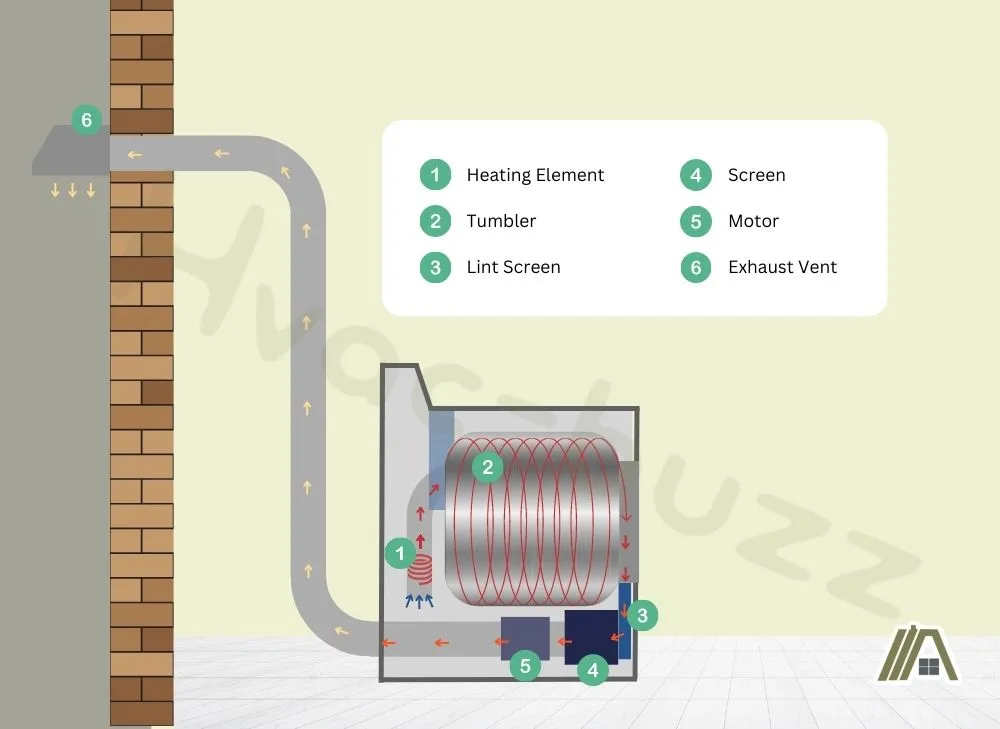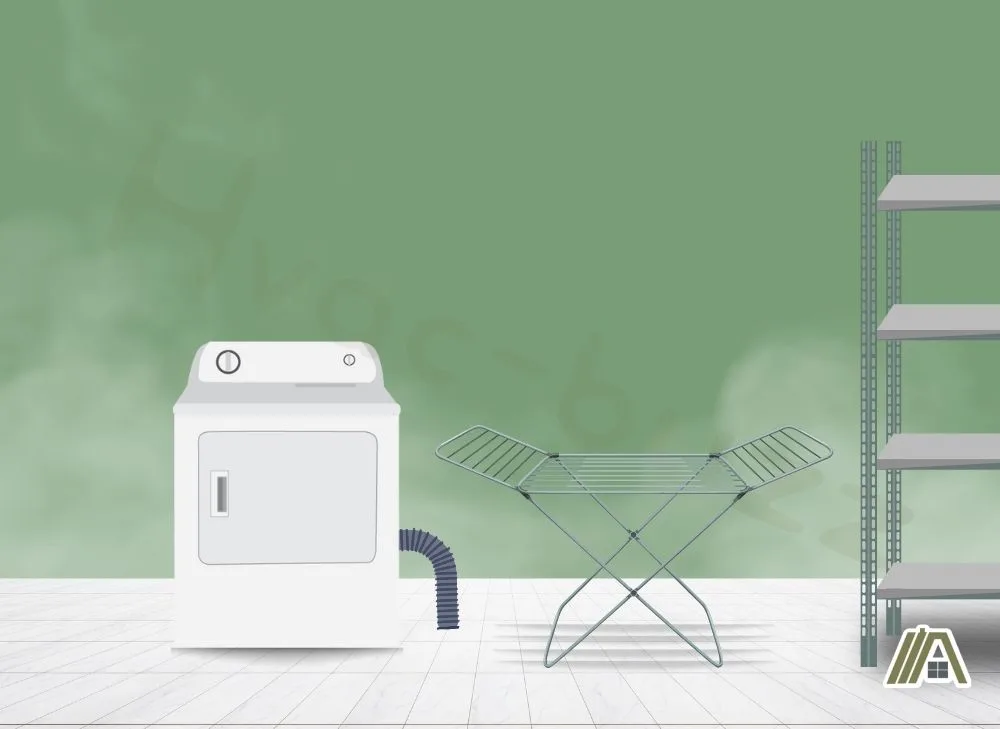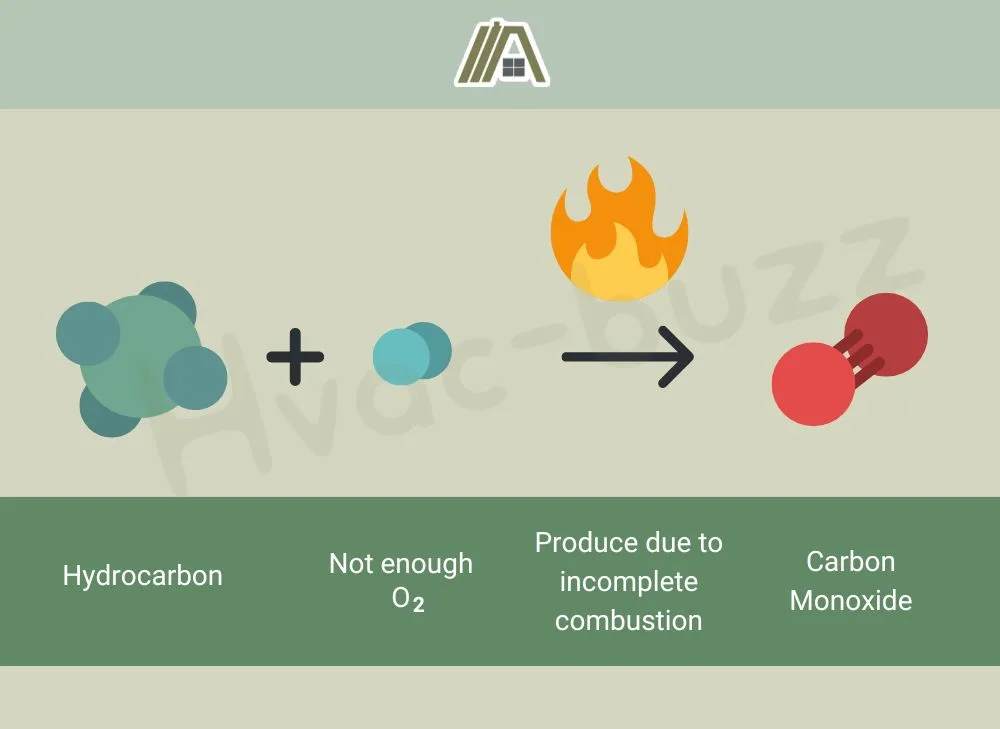Dryers must be vented to ensure hot and moist air doesn’t remain indoors. Combustion appliances are vented to ensure that harmful combustion gases are not released into confined spaces. But if you examine a gas dryer, there is only one vent.
You aren’t the first to wonder or worry about the exhaust from a gas dryer, but all you need is a little bit of knowledge about the inner workings of a gas dryer. And, just to set your mind at ease, if your gas dryer was properly installed, then the combustion gases are not being released into your house.

Combustion gas forms in the gas assembly during the combustion process. It travels with heated air through the drum, the internal dryer vent, to the exhaust outlet. This is intended to be connected to ductwork terminating outside to protect the house from dangerous gases.
Combustion Gases Form in the Gas Assembly
When something rapidly reacts with oxygen to create heat, this is called combustion. This process occurs in the gas assembly of a gas dryer, where an igniter, natural gas, and air are combined.
The resultant heat from the combustion process is used to heat air that cycles through the drum and dries the clothing inside.
However, heat is not the only byproduct of combustion (also called “exhaust”) that originates from the gas assembly. There are also combustion gases.
The composition of combustion gases depends on the fuel, but for natural gases, this includes small amounts of carbon dioxide, carbon monoxide, and nitrogen and sulfur oxides.
The Gas Passes Through the Dryer With the Hot Air
With the movement of air through the dryer, these combustion gases don’t stay put. Instead, they move with the heated air through the appliance.
The air is blown into the rotating drum. This allows the hot air to mingle with the wet dryer load and evaporate water from the material.
At this point, the air carries heat, combustion gases, water, and lint.
All Air and Gas Leave Dryer Through Back Vent
When the air is saturated with moisture from the drying clothes, the humid air, gases, and lint pass out of the drum.

They are channeled through a lint filter and into the vent on the other side of the drum. Much of the lint is removed, but not all of it.
Once inside the vent, a fresh supply of heated air (also containing combustion gases) enters the drum, and the “old” air is pushed out of the back of the dryer into a ductwork system.
Vent Should Lead Outside Through Ductwork
Now, your gas dryer can’t (or shouldn’t) just let exhaust out in your home.
With any vented dryer, the air released contains moisture and heat, which are bad for your home and health.
When it comes to gas dryers, as we have just learned, this air will also contain all the combustion gases produced as the fuel burns.
The combustion gases are formed in small amounts during combustion. However, constantly letting these substances into your living and breathing space can become harmful, especially carbon monoxide, which is highly toxic and very hard to detect.
It is for this reason that building codes (which are legally binding) stipulate that the exhaust outlet at the back of the dryer should be connected to ductwork.
According to Sections M1502.2 and M1502.3 of the International Residential Code (IRC), this ductwork should be independent of other systems and must terminate outdoors.
The IRC has specific regulations for the ducting and vent termination of a dryer’s exhaust system and even the clearances of the termination point, which are all designed to keep you safe.
Other Possible (and Illegal) Terminations
Electric dryers have other termination and venting methods because ventless versions are available. However, this is safe enough due to the lack of combustion gas and the alternative provisions for moisture and lint.
Some people try other methods of venting or non-venting, which are illegal (according to the IRC requirements), even if they are commercially sold.
Let’s look at some of the illegal methods people use or may be tempted to use.
Back Vent Doesn’t Lead Anywhere
The first setup that is sometimes seen is possibly the worst.
In this setup, the gas dryer is installed, and no ductwork is connected to the back of the dryer outlet at all.
This means that the dryer vent leads nowhere, and all the exhaust is released directly into the laundry (or whatever room your dryer is in), and from here, it can move into the rest of the home.

Without a vent or any kind of filtering or collection system, the dryer dumps the hot air, the moisture, the lint, and the combustion byproducts into your living space.
Back Vent Leads to a Condenser Box
If you have ever Googled alternatives to venting a dryer, you may have come across a condenser box.
This seems like a great ductless option, so you don’t have to go through the hassle and cost of cutting holes into your house and laying ducts for the dryer. I mean, you can even build a condenser box yourself.
Condenser boxes consist of a plastic container and flexible piping that is supposed to hold the hot dryer air while it cools. The container then collects the condensation and lint that is deposited.
Unfortunately, not only is a condenser box illegal, but it doesn’t even work passably well to warrant the effort of trying.
Back Vent Leads to Indoor Ventilation Kit
Indoor dryer kits are another one of those alternatives to ductwork that you can come across online. They are even sold in many stores.
Indoor ventilation kits are similar to condenser boxes in that they consist of a pipe and container that you can attach to your dryer’s vent. Yet, they are even less effective than condenser boxes.
The problem here is that these indoor ventilation kits are glorified lint filters. All the hot, moist, and combustion gas-containing air will simply pass through the pipe and be released into your home unhindered.
Combustion Gases Dangerous Unless Directed Outside
We’ve spoken so much about how you don’t want combustion gases in your home; I think that it’s about time we get to the reason why.
You probably have a good idea as to the reason, but perhaps you are unaware of the finer details.
Probably the main concern is the carbon monoxide coming from the combustion process. This is a flammable gas that can cause fires and explosions, and it is harmful to your health.
Constant exposure to carbon monoxide causes carbon monoxide poisoning. The gas displaces oxygen in the blood, resulting in various symptoms, including respiration difficulties, headaches, nausea, and dizziness.
If the case is severe, it can cause seizures and lead to fatalities.
However, if your dryer is producing lots of carbon monoxide, then something is wrong with the combustion process.
This gas is only produced in significant quantities when there is insufficient oxygen, which should not be a problem if the gas dryer is installed correctly, including the provision of combustion air.

But the normal byproduct, carbon dioxide, is not without its risks either.
Carbon dioxide exposure can produce similar problems to carbon monoxide since it can also displace oxygen when it builds up in a home.
Nitrogen oxides, even at low levels, can cause irritation and damage to the respiratory system, eyes, and skin. It can also result in fatigue, nausea, and fluid buildup in the lungs.
Sulfur dioxide causes similar symptoms in terms of irritating the eyes and respiratory system.
Thus, it is easy to see that the substances contained in combustion gas must be ejected from the house. Otherwise, they can become a danger to you and your family.
Sources
https://www.grc.nasa.gov/www/k-12/airplane/combst1.html
https://www.dhs.wisconsin.gov/chemical/carbondioxide.htm
https://www.mayoclinic.org/diseases-conditions/carbon-monoxide/symptoms-causes/syc-20370642
